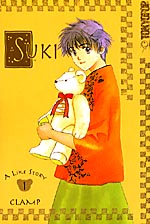 By CLAMP
By CLAMP
192 pages, black and white
Published by TokyoPop
One of the problems of being a collective of writers and artist who all use the same name is that as a reader you never really know what you’re going to get. That’s how I feel about CLAMP, a four-woman creative team in Japan. For every CLAMP book I’ve loved like Cardcaptor Sakura or Wish, there are ones like Clover which just don’t seem to work quite as well. I’m not sure just what made me decide to give CLAMP’s Suki: A Like Story a try, but I’m really happy that I did. This is definitely one of the CLAMP books that fall into the “good” category for me.
Hinata Asahi is a high school student whose emotional growth doesn’t seem to have caught up with her body. She’s like a child, living with just her two teddy bears whom she reads fairy tales to and makes pancakes for. Then the big house next door gets a new tenant, Shiro Asou. There’s something about Shiro that makes Hina’s heart go wild, experiencing feelings she’s never had before. When Shiro turns out to also be her new homeroom teacher, it seems too good to be true. Unfortunately, that might just be the case.
 CLAMP’s story for Suki: A Like Story reminds me a bit of Wish in that on the surface it seems to be one sort of story, but there’s much more than really meets the eye waiting for the reader. (Perhaps not coincidentally, both projects were headed up by the same member of CLAMP.) At first, Suki (which means “to like” in Japanese) seems to be just a story about an emotionally stunted girl coming into her own as a person. The more you read, though, the more you discover lurking beneath. There’s definitely a sinister storyline unfolding here as we start to get hints on how Shiro’s presence in Hina’s life is anything but coincidental, and is quite possibly dangerous for Hina. Once you add in the mystery of why Hina’s living apart from her father and her best friend transferring schools to stay with her, and it’s hard to keep from being really intrigued as to what happens next in Suki. All the while, though, CLAMP keeps the initial aspect of Suki present as Hina continues to feel these strange new emotions running through her body.
CLAMP’s story for Suki: A Like Story reminds me a bit of Wish in that on the surface it seems to be one sort of story, but there’s much more than really meets the eye waiting for the reader. (Perhaps not coincidentally, both projects were headed up by the same member of CLAMP.) At first, Suki (which means “to like” in Japanese) seems to be just a story about an emotionally stunted girl coming into her own as a person. The more you read, though, the more you discover lurking beneath. There’s definitely a sinister storyline unfolding here as we start to get hints on how Shiro’s presence in Hina’s life is anything but coincidental, and is quite possibly dangerous for Hina. Once you add in the mystery of why Hina’s living apart from her father and her best friend transferring schools to stay with her, and it’s hard to keep from being really intrigued as to what happens next in Suki. All the while, though, CLAMP keeps the initial aspect of Suki present as Hina continues to feel these strange new emotions running through her body.
Suki has the same lead artist (Mick Nekoi) as Wish did, and it really shows. The characters in Suki are drawn in a beautiful minimalist style that makes everyone look slightly fragile—something that’s carried through in the writing as well. For a character as innocent as Hina she needs to look the part, and it’s achieved here in part by having every emotion experienced by her cross her face and body. Fear, excitement, disappointment, delight… there’s no such thing as a poker face for Hina. Conversely, Shiro’s expressions are always inscrutable, the ultimate example of a character giving absolutely nothing away by his body language. It’s a very attractive book, and it’s almost as much fun to just flip through the book at random and enjoy the craft involved as it is to read.
Suki Vol. 1 is a great opening to the story, moving at just the right pace for a three-volume series. There are a lot of different directions it can go from here, and to be honest, there’s enough groundwork laid that I think I’ll be happy no matter what the ending. Special note also has to be brought to the paper stock for the cover and the interiors, which seems to be of a different, higher quality than what TokyoPop uses. It helps with the overall package in looking even more attractive, and I’d love to see this become a standard for TokyoPop. All in all, a real joy from beginning to finish.
Purchase Links: Amazon.com
